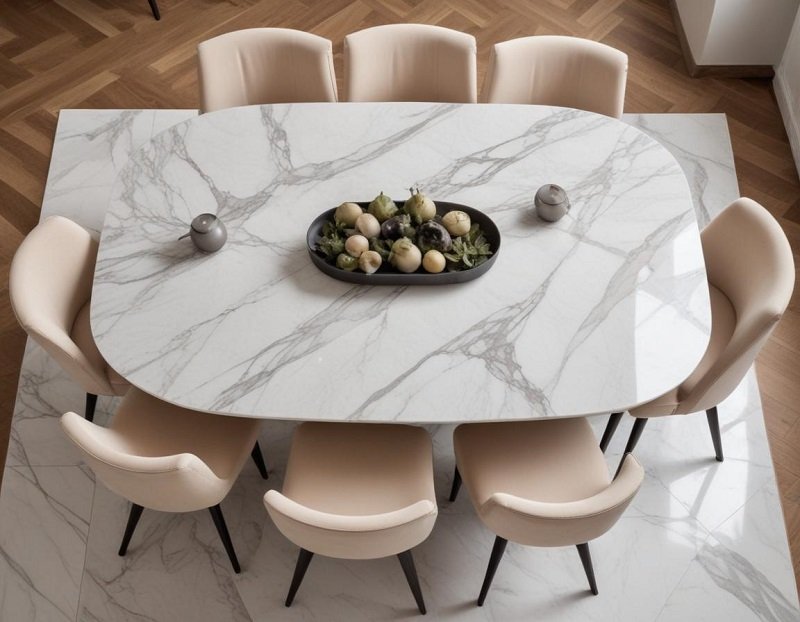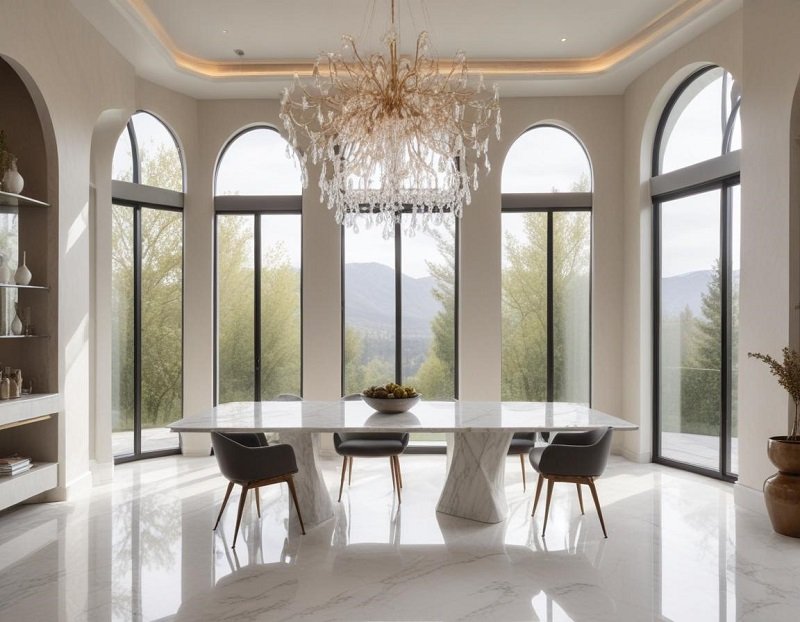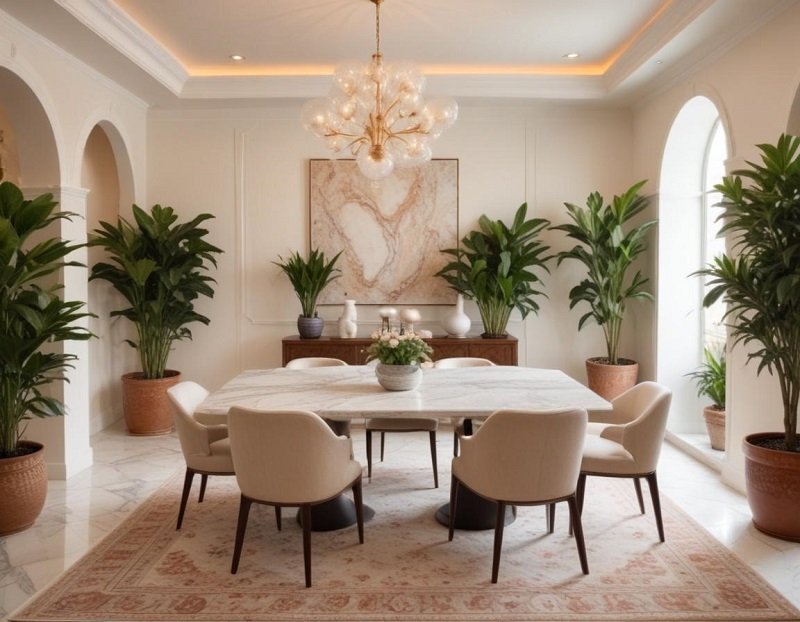- Living Room
- Dining Room
- Bed Room
- Custom Furniture

Discover the epitome of personalization with our Canadian-made furniture
Choose from a range of fabrics or luxuriant top-grain leather to create your perfect piece. Our expert team will guide you through the customization process, ensuring every detail is tailored to your taste and home. Elevate your space with furniture that's uniquely yours.
- Michael Amini Collection
- Sale
Pros & Cons of Having a Marble Dining Table

Introduction
A dining table is more than simply a useful piece of furniture. It’s where families gather, parties take place, and memories are etched into the fabric of everyday life. Few materials rival marble’s beauty and sophistication when making a statement in your dining room. Its timeless attractiveness can quickly change any place, making it appear elegant and luxurious. However, before you hurry to add a marble dining set to your home, you should first grasp the implications of this daring decision.
Imagine stepping into a room with a marble dining table in the center, shining beneath the light, each swirl and vein unique to that piece. It gives a feeling of permanence and grandeur as if the table has stories to tell from ages ago. Whether you’re having a family meal or a formal party, the table serves as more than simply furniture; it’s also a conversation starter.
However, marble, like all beautiful things, requires upkeep. It’s not simply a payment; it’s a commitment. For some, it represents exquisite taste and a long-term investment, yet for others, it may feel like a delicate work of art that needs constant attention. So, is a marble dining set a good decision for you? Let’s look at the pros and cons so you can make an informed decision that suits your style and lifestyle.
Pros of Marble Dining Tables
Marble has always been admired for its grandeur and unique character. If you’re thinking about adding a marble dining set to your home, the first thing that springs to mind is its stunning elegance. But there’s more to marble than meets the eye—let’s look at the benefits.
1- Aesthetic Appeal
Marble has an undeniable visual attraction. Its natural patterns are sometimes compared to works of art, as no two slabs are ever alike. A marble dining set is a one-of-a-kind piece of furniture. The tiny veins that flow over its surface add a degree of refinement and uniqueness that other materials cannot match. It’s like having a painting by nature herself sitting in the heart of your dining room. The colors range from creamy whites and delicate pinks to dramatic blacks and greens, providing alternatives to complement any dining room set.
2- Durability and Longevity
Marble is frequently regarded as fragile, yet when properly cared for, it is quite durable. In reality, many antique marble dining sets have been passed down through generations, keeping their beauty in the process. It’s a material that ages nicely, acquiring a patina over time that adds to its appeal. In this sense, a marble dining set is more than simply a table; it’s a heritage. With frequent sealing and careful maintenance, your marble table can withstand the test of time, serving as the centerpiece for countless family dinners, celebrations, and memories.
3- Versatility in Design
One of the marble’s greatest advantages is its adaptability. Whether your home is furnished in a contemporary, classic, or rustic style, a marble dining set may enhance and elevate the entire look. The natural stone looks well with a variety of dining room sets, including sleek modern chairs and antique wooden pieces. Marble is not just appropriate for high-end, ultra-modern settings; it may also work well in houses that value warmth and comfort.
Cons of Marble Dining Tables
As alluring as marble is, it’s important to consider the other side of the equation before committing to a marble dining set. While its beauty and uniqueness are undeniable, marble also comes with its own set of challenges, which may affect how well it fits into your home and lifestyle.
1- Prone to Scratches and Etching
Despite its durability, marble is a soft, porous stone that is easily scratched and damaged. Even something as basic as a lemon wedge or a spilled glass of wine may create a mark. If your dining table is the focal point of everyday activity—where children do schoolwork, visitors gather for meals, and family projects are completed—a marble table may not be able to endure regular usage without displaying signs of wear.
2- High Maintenance
Marble takes greater maintenance than most other dining table materials. Sealing it regularly is required to maintain its shine and prevent harm. Without a sealant, the surface is prone to stains and etching, especially from acidic liquids like citrus, vinegar, and red wine. This implies that spills must be cleaned up quickly, and coasters should always be on hand.
3- Weight
Marble is a heavy material, so keep this in mind if you want to move or rearrange your furniture frequently. When a marble dining set is installed, transporting it becomes a logistical challenge—lifting and transferring the table will take more than one or two persons. If you live in a limited place or want to downsize, the table’s weight may be a limiting factor.
4- Cost
Marble is not only heavy, but it is also an expensive material. A high-quality marble dining room set is normally more expensive than other materials such as wood, glass, or metal. While it is a long-lasting material, the initial cost may be challenging for those on a limited budget. You’re paying for more than just the beauty; you’re also paying for the craftsmanship, the uniqueness of each slab, and the durability it promises.
Tips for Maintaining Marble Dining Tables
- Regular Sealing: The most important step in maintaining your marble dining room set is to seal the surface. Sealants operate as a barrier, preventing liquids from seeping into the stone and leaving stains or etches. Depending on the type of marble and how frequently you use your table, it’s best to protect the surface once or twice a year.
- Immediate Cleanup: One of the golden rules of marble maintenance is immediate cleanup. Because marble is porous, it absorbs liquids quickly, which can lead to permanent stains. Whether it’s red wine, coffee, or even water, the key to preserving your marble dining set is to act fast when spills happen.
Things That Will Stain Marble
One of the most important components of owning a marble dining set is knowing what might harm or discolor this stunning stone. Marble is a beautiful and exquisite material, but it is also extremely porous and vulnerable to a variety of chemicals that can leave lasting stains.
- Acidic Substances: Marble is mostly composed of calcium carbonate, which interacts with acids, resulting in etching. This is why acidic things such as citrus juices, vinegar, tomatoes, and wine are very harmful to your marble dining room set. Even a minor spill might result in a dull patch on the surface that is difficult to fix.
- Oils and Grease: Oil-based stains can be tricky to deal with on marble surfaces. Cooking oils, butter, and greasy foods can seep into the stone and leave behind dark spots. Because marble is porous, these stains may become embedded within the surface if they’re not cleaned up quickly.
- Colored Liquids: Deep-colored liquids such as coffee, tea, wine, and even fruit juices can leave major stains on your marble dining table if left for too long. Because marble absorbs liquids fast, you must be proactive in cleaning up accidents as soon as they occur.
Best Uses for Marble Table Tops
Marble may not be the right fit for every household, but in certain settings, it shines. The elegance and uniqueness of marble make it perfect for specific types of dining sets and dining environments.
- Formal Dining Spaces: Marble is often seen as a sign of elegance and sophistication, making it an ideal choice for formal dining rooms where entertaining guests is important. In such settings, when the table serves primarily for formal meals, special events, or holiday feasts, a marble dining room set may improve the overall beauty of the space.
- Homes with Minimal Daily Use: For homes where the dining area isn’t used heavily on a day-to-day basis, marble can be a great option. If your dining set serves more as a decorative element or is reserved for the occasional dinner party, then the maintenance and risks associated with marble may be less of a concern.
- Aesthetic-Focused Spaces: Some homeowners value aesthetics above everything else, and the magnificent visual appeal of marble surpasses any possible disadvantages. A marble dining room set complements houses that value design, with each piece of furniture picked for its beauty and creative excellence.
Conclusion
When choosing a marble dining set, it is important to examine the benefits and drawbacks of purchasing one. Marble’s beauty, originality, and timeless appeal make it an appealing choice for many people, but it requires care and attention that other materials do not. From regular maintenance to dealing with the possibility of stains and scratches, marble is best suited for those who value its beauty enough to devote the time and effort necessary for its care.
In Venus Home, we frequently advise our clients that having marble is similar to owning a work of art—beautiful and one-of-a-kind, but something that must be cared for to stay in top shape. If you’re willing to make the effort, a marble dining set may be a gorgeous addition to your home, providing a dining room set that is both useful and an attraction to ageless beauty.
FAQs
1- Will a Marble Dining Table Scratch Easily?
Yes, marble is a relatively soft stone, so it is susceptible to scratching, especially if sharp or rough objects are dragged across its surface. Everyday activities like placing dishes or utensils can cause minor scratches over time. However, using protective measures like placemats, coasters, and felt pads can significantly reduce the risk of damage.
2- How Do I Clean My Marble Dining Set Without Damaging It?
For regular cleaning, use a soft cloth and warm water with a mild, pH-neutral cleaner specifically designed for stone. Avoid harsh chemicals or abrasive scrubbers, as they can dull the marble’s finish or cause etching. For tougher stains, a paste of baking soda and water can be gently applied, but always test in a small, inconspicuous area first.
3- Can I Use a Marble Dining Set in a Family Home?
Yes, but with caution. If you have children or a busy household, you’ll need to be more vigilant about spills and scratches. Using tablecloths or glass covers can help protect the surface, but you’ll need to consider if the potential for damage outweighs the beauty marble brings to your space.
4- How Often Should I Seal My Marble Table?
To maintain its durability and prevent stains, it’s recommended to seal your marble dining room set every 6-12 months. The sealer helps block liquids from penetrating the stone, reducing the risk of permanent stains. High-use tables may need more frequent sealing, especially if exposed to heavy use or acidic substances.
5- What Is the Best Way to Protect My Marble Dining Set from Stains?
The best protection is prevention. Wipe up any spills immediately, especially liquids like wine, coffee, or acidic substances. Using coasters, placemats, and tablecloths can prevent direct contact with the marble surface, safeguarding it from potential damage.
6- Can Heat Damage Marble?
Yes, placing hot pots, pans, or dishes directly onto a marble dining set can cause discoloration or cracks due to thermal shock. Always use trivets or heat-resistant mats to protect the marble from extreme temperature changes.
7- Is a Marble Dining Table Heavy?
Absolutely. Marble is a dense material, making a marble dining room set quite heavy and challenging to move. While its weight adds to its sturdiness and stability, it’s important to consider whether your dining room floor can support the table’s weight, particularly if you live in an older home or apartment.
8- What Are the Alternatives to Marble Dining Sets?
If you’re drawn to the look of marble but concerned about its maintenance, quartz is a popular alternative. Quartz offers the same luxurious appearance but is more resistant to stains, scratches, and etching. It requires less maintenance and can be a great option for busy households.
9- How Does Marble Hold Up Over Time?
With proper care, marble can last for many years, even decades, retaining its beauty. However, natural wear and tear, as well as environmental factors like sunlight exposure, can cause the marble to fade or lose its shine over time. Routine maintenance like sealing and polishing can help preserve the marble’s appearance.
10- Is a Marble Dining Set a Good Investment?
For those who value aesthetic appeal and are willing to care for their marble dining room set, it can be a worthwhile investment. Marble has a timeless beauty and can significantly elevate the overall look of your dining space. However, if low maintenance and durability are your priorities, you may want to consider other materials that require less upkeep.

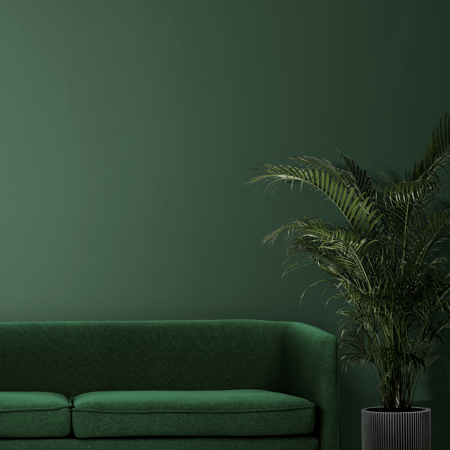
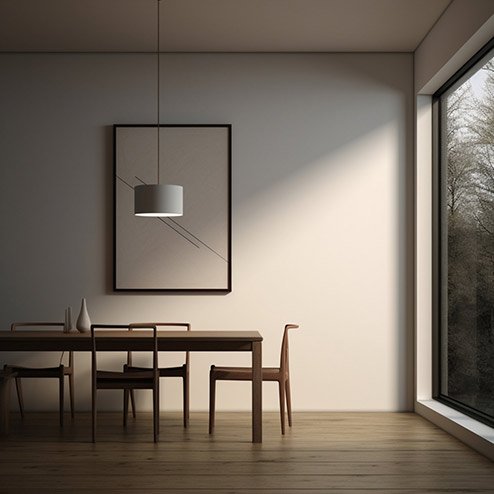
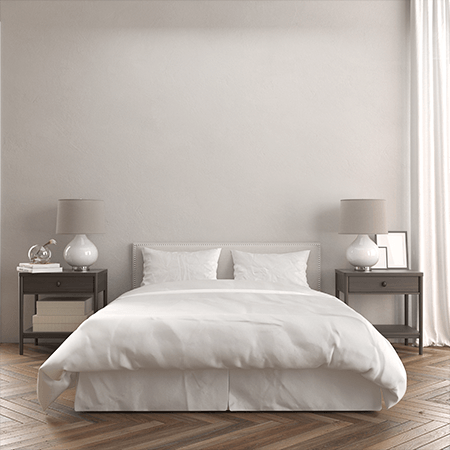
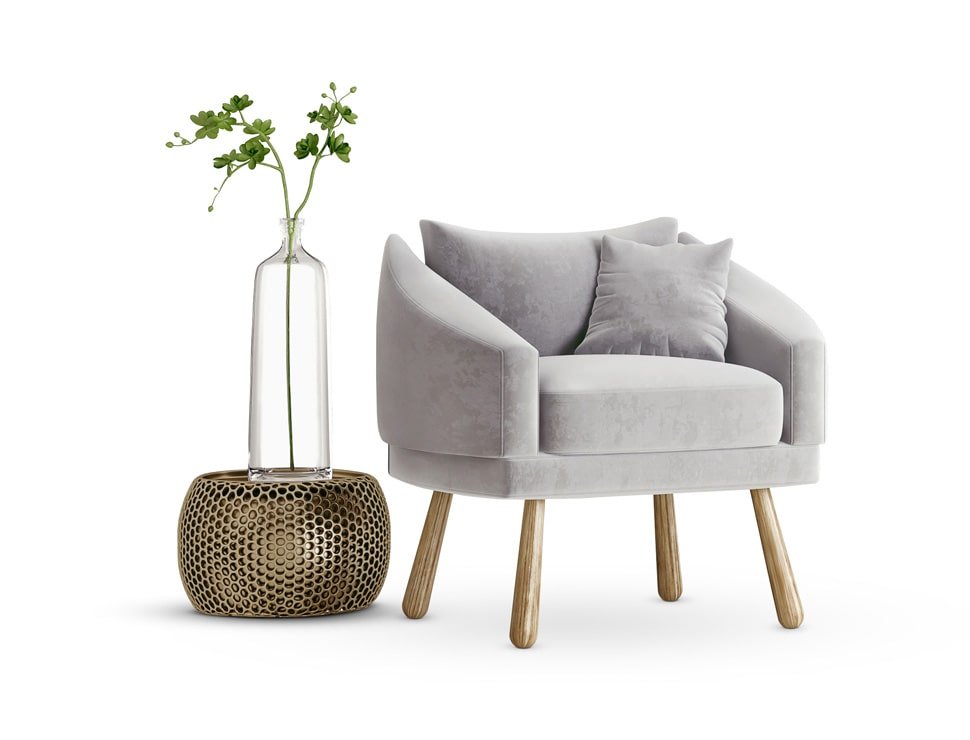
 Chandeliers
Chandeliers Clocks
Clocks Decorative Accent
Decorative Accent Mirrors
Mirrors Floor Lamps
Floor Lamps Table Lamps
Table Lamps Wall Art
Wall Art
